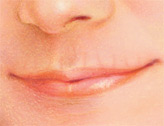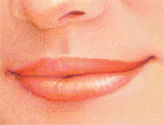As we age, our faces begin to show the effects of gravity, sun exposure and years of facial muscle movement, such as smiling, chewing and squinting. The underlying tissues that keep our skin looking youthful and plumped up begin to break down, often leaving laugh lines, smile lines, crow’s feet or facial creases over the areas where this muscle movement occurs. Soft-tissue fillers, most commonly injectable collagen, hyaluronic acid, or fat, can help fill in these lines and creases, temporarily restoring a smoother, more youthful-looking appearance.
If You’re Considering Injectables…
When injected beneath the skin, these fillers plump up creased and sunken areas of the face. They can also add fullness to the lips and cheeks. Injectable fillers may be used alone or in conjunction with a resurfacing procedure, such as a laser treatment, or a recontouring procedure, such as a facelift.
What are the different types of fillers?
Collagen is a natural protein that supports the skin. Injectable collagen formulas derived from human dermis include Cosmoderm or Cosmoplast. Zyderm and Zyplast are forms of bovine collagen that, unlike human derived collagen, require prior allergy testing. The results may last 2 to 4 months.
Hyaluronic Acid is a natural substance found in our bodies. It is well suited to plump thin lips and fill facial creases such as nasolabial folds. It may also be appropriate for some surface wrinkles and concave scars. The results may last 6 months or longer.
Hydroxylapatite is a mineral-like compound found naturally in human bones, suspended in a gel-like formulation. It is the heaviest of facial fillers and is recommended to fill deeper creases such as nasolabial folds, marionette lines and frown lines, as well as to enhance fullness of the cheeks and other facial contours.
Human fat, harvested from your own body, can be reinjected to enhance facial fullness, fill deep creases and to build up shallow contours. Fat injection requires a more extensive procedure than other injectable fillers because it uses liposuction techniques to extract the fat prior to injection.
PMMA (polymethylmethacrylate) fillers contain 20% tiny PMMA microspheres suspended in 80% purified collagen gel. An FDA-approved PMMA filler is recommended for the correction of facial wrinkles known as smile lines.
What to Expect from Treatment
The most important fact to remember about injectable fillers is that the results are not permanent. Injected material is eventually metabolized by the body. You should not expect the same long-lasting results that may be gained from cosmetic surgery.
In some individuals, the results may last only a few weeks; in others, the results may be maintained indefinitely. Researchers believe that age, genetic background, skin quality and lifestyle as well as the injected body site may all play a role in the injected material’s “staying power.” However, the precise reason for the variation of results among patients has yet to be identified.
If you’ve had short-lived results from fat injections, you shouldn’t necessarily assume that collagen injections will work better for you. And, conversely, if you’ve had disappointing results from collagen, don’t assume that injected fat is the answer. Although it’s true that some individuals’ bodies are more receptive to one substance than the other, others may find that neither substance produces long-lasting results. Sometimes one substance may work better than the other for a specific problem.
Risks Related to Injectables
When injectables are administered by a qualified plastic surgeon, complications are infrequent and usually minor in nature. Still, individuals vary greatly in their anatomy, their physical reactions and their healing abilities. The outcome of treatment with injectables is never completely predictable.
Hyaluronic Acid: side effects are typically mild or moderate in nature and last for less than 7 days. Adverse events include redness, pain, firmness, swelling, lumps/bumps, bruising, itching, and discoloration.
Collagen: Allergic reaction is the primary risk of collagen. To help determine if you are allergic to the substance, your surgeon will perform an allergy skin test about a month before the procedure. After the test is performed, the test site should be watched carefully for three or four weeks, or as long as your surgeon advises. Any sign of redness, itching, swelling or other occurrences at the test site should be reported to your surgeon.
Risks not necessarily related to allergies include infection, abscesses, open sores, skin peeling, scarring and lumpiness, which may persist over the treated area. Reports of these problems are very rare.
Fat: Allergic reaction is not a factor for fat because it’s harvested from a patient’s own body. However, there is still a small risk of infection and other infrequent complications.
Planning for Treatment
Facial rejuvenation is very individualized. That’s why it’s important to discuss your hopes and expectations with a board-certified plastic surgeon who has experience with many different types of surgical and non-surgical facial procedures.
In your initial consultation, your plastic surgeon will evaluate your face – the skin, the muscles and the underlying bone – and discuss your goals for the surgery. Your doctor will help you select a treatment option based on your goals and concerns, your anatomy and your lifestyle.
Your surgeon will ask you about your medical history, drug allergies, and check for conditions that could cause problems, such as active skin infections or non-healed sores from injuries. Collagen injections are generally off limits for pregnant women, individuals who are allergic to beef or bovine products, patients who suffer from autoimmune diseases, and those who are allergic to lidocaine (the anesthetic agent contained in the syringe with the collagen material). For more specific information about the contraindications and risks of collagen use, ask your doctor for the manufacturer’s brochure for patients.
Insurance usually doesn’t cover cosmetic procedures. However, if your injectable treatment is being performed to treat a scar or indentation from an accident or injury, you may be reimbursed for a portion of the cost. Check with your insurance carrier to be sure.
Where Your Treatment Will Be Performed
Injectables are usually administered in a surgeon’s office-based facility. If, however, you are being hospitalized for a facelift, neck lift, brow lift, or any other procedure, your injections may be administered in the hospital as well.
Types of Anesthesia
Collagen: Because the anesthetic agent lidocaine is mixed in with collagen, additional anesthetic is usually not used. However, if you are especially sensitive to pain, your doctor may use a topical cream anesthetic or a Freon spray to numb the injected area. Or, you may elect to have an injected local anesthetic or sedative drugs.
Fat: Both the donor and recipient sites are numbed with local anesthesia. Sedation can be used as well. If you elect to use sedation, be sure to arrange for a ride home after your treatment.
Collagen Injection
Collagen is a naturally occurring protein that supports tissue of the skin, joints, bones and ligaments. Injectable collagen can be derived from purified bovine collagen, porcine collagen or human sources. The purification process ensures the product is similar to human collagen. Injectable collagen is produced in varying concentrations to meet individual patient needs.
Collagen is used primarily to fill wrinkles, lines and scars on the face and sometimes the neck, back and chest. First, a skin test determines if you are allergic to the substance. If you are not allergic, the collagen is injected at several points along the edge of the targeted area. Local anesthesia can be used to control discomfort as the injections are administered. Because part of collagen is salt water that will be absorbed within a few days, your doctor may slightly overfill the area. You may be asked to hold a hand mirror during the procedure to help your doctor decide when you’ve had enough.
After treatment, you may notice some minor discomfort, stinging or throbbing in the injected area. Occasionally some bruising or swelling will occur, but it is usually minor. Redness that appears in the injected site usually disappears within 24 hours. However, in some individuals, particularly fair-skinned patients, this redness may persist for a week or more. Tiny scabs may also form over the needle-stick areas; these generally heal quickly.
No bandaging is needed and you are free to eat, drink, and wear makeup with sunblock protection shortly thereafter. There may be some temporary swelling and redness in the treated area which should dissipate within a few days. If these symptoms persist, contact your surgeon.
The duration of your results will vary. In general, the injected material is likely to disappear faster in areas that are more affected by muscle movement. Your doctor can help you determine how long you can go between treatments to best maintain your results.
Fat Injection
Fat-injection procedure is also known as autologous fat transplantation or micro-lipoinjection. Fat cells are extracted from the patient’s abdomen, thighs, buttocks or elsewhere and reinjected beneath the facial skin. Fat can fill in sunken cheeks or lines between the nose and mouth, correct skin depressions, minimize forehead wrinkles or enhance the lips.
After cleansing and treatment with local anesthesia, fat is withdrawn using a syringe with a large-bore needle or a liposuction cannula. The fat is then prepared and injected into the recipient site with a needle. Sometimes an adhesive bandage is applied over the injection site. Slight overfilling may be necessary to allow for fat absorption that occurs. When fat is used to augment the cheeks, this overcorrection may cause the face to appear abnormally full.
While some treatments require a brief recovery period, many patients resume normal activity right away. Expect some swelling, bruising or redness in both the donor and recipient sites. The severity of these symptoms depends upon the size and location of the treated area. Stay out of the sun until redness and bruising subsides – usually about 48 hours. In the meantime, you may use makeup with sunblock protection to help conceal your condition. In some cases, swelling and puffiness in the recipient site lasts several weeks, especially if a large area was filled.
While some patients report results lasting 1 year or more, the majority of patients find that at least half of the injected fullness disappears within 3-6 months. Therefore, repeated injections may be necessary. Your doctor will advise you on how to maintain your results with repeat treatments.
Your New Look
If you’re like most patients, you’ll be very satisfied with the results of your injectable treatments. You may be surprised at the pleasing results that can be gained from this procedure.






